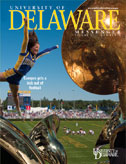Around the world, one math class at a time
RESEARCH | With numerous studies showing U.S. students lagging behind their international counterparts in math and science achievement, James Hiebert set out to learn why.

Hiebert, Robert J. Barkley Professor of Education, decided to explore whether the way math is taught in the United States is somehow less effective than the methods teachers in other countries use. To find out if that was the case, he took a close look inside classrooms around the world where students perform well.
The result was a five-year study led by Hiebert to observe different teaching styles in eighth-grade math classrooms in the United States, Australia, Czech Republic, Hong Kong, The Netherlands, Japan and Switzerland. Those countries were selected by the National Center for Education Statistics to represent high student performance in various regions, Hiebert says.
The information was collected from 1999 to 2004 and is continuing to yield results as it is studied. Eighth grade was selected for the study because it is the oldest age achievement marker across the world on which all countries are comparable, Hiebert says.
In addition to learning about different methods of teaching used around the world, he says one of the most useful aspects of conducting an international study is that he was able to use comparisons to learn more about what teachers in the United States do.
“I think one of the most valuable things about doing cross-cultural studies is that it helps you see your own culture more clearly,” Hiebert says. “There are certain things we do when we teach mathematics that we just do routinely; we don’t even question them. But when you see another country teaching in a different way, you say, ‘Oh, wow, maybe we don’t have to do it exactly our way.’”
Teachers were randomly selected and told to teach their usual lessons on the day a film crew came into their classrooms to get a national picture of how math instruction looked in each country. The goal was to describe the learning experiences of most students on an average day.
The study identified 75 variables in which there were differences in teaching patterns among the seven countries, but Hiebert says two of those stood out as the most common in the highest-achieving countries, but nearly absent in the United States. Both those features are significant because they have been shown to help students understand the content taught in math classrooms, he says.
The first feature is that at some point during the lesson, either the teacher or the students make public, and very explicit, what the important mathematical relationships are that provide the focus for that lesson. The second feature that was observed is that at some point, students are asked to wrestle with an important mathematical idea; they are given a problem to solve for which they do not know the answer, or they are posed a question that doesn’t have an immediately clear answer.
Hiebert says that while there are aspects of American teaching techniques that could be modified as a result of the study, people should be cautious about assuming that importing a new method of teaching learned from the study into the United States will be successful.
“There are many other cultural factors that affect achievement,” he says. “Teaching is just one of them.”
Article by Jon Bleiweis, AS ’10





